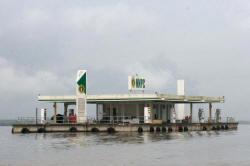Crude or condensate? The dilemma over Nigeria's oil-cut
exemption
 Send a link to a friend
Send a link to a friend
 [October 20, 2017]
By Libby George [October 20, 2017]
By Libby George
LONDON (Reuters) - When OPEC agreed to
exempt Nigeria from its oil production-restraint deal last year, it knew
the country faced a huge challenge in recouping output lost due to
militant unrest.
As tensions subside and the country pumps closer to normal levels,
another dilemma looms for the producer group as it continues efforts to
eradicate a price-sapping oil glut - how to count Nigeria's crude output
without mixing in condensates.
The answer could determine when – and indeed if ever – Nigeria has to
cut or curtail oil production, its key source of foreign currency.
While Nigeria promised to cap at 1.8 million barrels per day (bpd) once
production "stabilizes", that limit exempts all of the West African
nation's condensates. And no one seems to agree on how much of that
ultra-light oil it pumps.

"Previously, due to the whole issue of militancy, quotas were not an
issue," said Gail Anderson, research director at consultancy Wood
Mackenzie. But now, "if you start thinking about OPEC cuts, then the
definition of crude and condensate becomes quite important".
Nigeria, along with OPEC peer Libya, was exempt from cuts due to
militancy in its Delta region that slashed output from 2.2 million bpd
to as low as 1.2 million bpd last year. The attacks have abated, with no
major incidents since January.
Nigeria's output has also rebounded, and secondary sources such as
consultancies and price-reporting agencies quoted by OPEC said it edged
above 1.8 million bpd in August and September - reinstating the country
as Africa's largest oil exporter.
But Nigeria has said some of that total included condensates, an
ultra-light oil that is not counted as part of its promise to cap.
Oil minister Emmanuel Ibe Kachikwu told Reuters in July that condensates
contributed 450,000 bpd to Nigeria's production that month.
The figure exceeds external estimates for condensate production ranging
from 200,000 to 250,000 bpd and suggests Nigeria's own condensate
definition could keep it out of any cap.
"Definition matters and all producers are playing with definitions,"
said Ehsan Ul-Haq, director of crude oil and refined products at
Resource Economist Ltd, a consultancy.
Neither Nigeria's state oil company, NNPC, nor its Ministry of
Petroleum, responded to Reuters requests for comment on its production
or definition of condensate.
WHAT'S IN A NAME?
Oil exists in many types of quality – from heavy, sulfur-rich Canadian
oil sands to ultra-light shale oil.

Condensates are liquefied once extracted from high-pressure reservoirs,
where they exist as a gas. Nearly all oilfields produce some
condensates, usually in small amounts. Once it becomes a liquid, there
is no widely agreed way to differentiate condensate from crude.
The Organization of the Petroleum Exporting Countries does not publish a
figure, reporting only the crude output of its 14 members, and NNPC also
publishes no condensate numbers.
Asked how OPEC would define condensate if it needed to determine
Nigerian production volumes, a spokesman for the producer group said the
definition was based on "international standards" such as those of the
American Petroleum Institute.
[to top of second column] |

A floating fuel filling station belonging to Nigeria’s state oil
firm Nigerian National Petroleum Corporation (NNPC) sits idle on a
river in the oil rich southeastern Delta state, Nigeria June 18,
2017. REUTERS/Tife Owolabi

But those standards focus on whether the oil was a gas when extracted. Once
liquefied, there is no widely agreed rule.
Often – including in Nigeria – condensates are blended into crude exports, and
not tracked carefully. The issue briefly flared when the U.S. shale revolution
led to a spike in oil production, and more would-be exporters sought to send oil
abroad as condensate, circumventing a ban on exports of crude. [http://reut.rs/2yzrJA8]
Washington lifted its export ban before it could craft a clearer definition.
This lack of consensus on what constitutes condensate makes it tricky to
determine how much any country produces.
"Nigeria does produce quite a bit of condensate, but apart from Akpo it's not
really measured because it's blended into crude," Wood Mackenzie's Anderson
said.
LABELS AND EXPORTS
Akpo, the only substantial Nigerian grade that trading and analyst sources told
Reuters is marketed as condensate, is typically exported at a rate of
100,000-133,000 bpd. Production of another condensate grade, Oso, has declined
so substantially that it is blended into Qua Iboe crude exports.
Late last year, the Paris-based International Energy Agency began counting
another Nigerian grade, Agbami, with 220,000-250,000 bpd of exports, as
condensate. Oil trading and industry sources told Reuters the grade is marketed
as crude oil, and the IEA declined to give a reason for the change.

Under IEA figures counting Agbami and Akpo as condensate, Nigeria's crude
production has not hit 1.8 million bpd since November 2015.
Despite a contrasting picture from OPEC's secondary-source figures, Nigeria's
direct communication with the organization has not shown crude output holding
above 1.8 million bpd in the past two years; the country's own full-year 2015
figure was 1.75 million bpd, with that for 2016 at 1.43 million bpd.
Other experts said hitting 1.8 million bpd without Agbami or Akpo would be tough
in the near term.
"They would have to ramp up existing production or bring new fields online,"
said Audrey Dubois-Hebert, senior oil analyst with FGE, an energy consultancy.
Wood Mackenzie estimates that export grades aside, roughly 12 percent of
Nigeria's production could be classified as condensate but that it could be
higher. This murky, but sizeable, chunk of output could keep Nigeria from
capping.
"Having a lot of wellhead condensate production could work to your benefit,"
Anderson said.
(Reporting by Libby George in London; Additional reporting by Alexis Akwagyiram
in Lagos, Paul Carsten in Abuja and Catherine Ngai in New York; Editing by Dale
Hudson)
[© 2017 Thomson Reuters. All rights
reserved.] Copyright 2017 Reuters. All rights reserved. This material may not be published,
broadcast, rewritten or redistributed.
 |